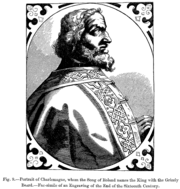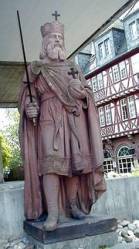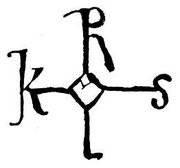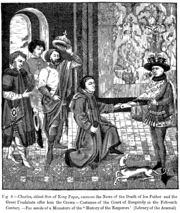

 Emperor Charlemagne
Emperor Charlemagne 


General Notes
Holy Roman Emperor.
King of the Franks.
Charlemagne (c. 742 or 747 - 28th of January, 814) (or Charles the Great, in German Karl der Große, in Latin Carolus Magnus, giving rise to the adjective form "Carolingian"), was king of the Franks from 771 to 814, nominally King of the Lombards, and Holy Roman Emperor - Imperator and Augustus.
Date of birth
Up until the mid-20th century, Charlemagne's birthday was believed to be the 1st of April, 742, but several factors led to reconsideration of this traditional date. First, the year 742 was calculated from his age given at death, rather than attested with primary sources. The second problem is that 742 precedes the marriage of his parents (in 744), yet there is no indication that Charlemagne was a bastard, and he inherited from his parents which ought not to have been possible under those circumstances. Another date is that given in the Annales Petarienses, the 2nd of April, 747. In that year, the 1st of April is Easter. Since the birth of an Emperor on Easter is a coincidence likely to provoke comment, there is suspicion evoked by the fact that there is no such comment documented in 747, leading some to suspect the Easter birthday was a pious fiction concocted as a way of honoring the Emperor. Other commentators weighing the primary records have suggested that the birth was one year later, 748. So at present, it is impossible to be certain of the date of the birth of Charlemagne. The best guesses include the 1st of April, 747, after the 15th of April, 747, or the 1st of April, 748.
Life
Arguably the founder of the Frankish Empire in Western Europe, Charlemagne was the elder son of Pepin the Short (714 - 24th of September, 768, reigned 751 - 768) and his wife Bertrada of Laon (720 - 12th of July, 783); he was the brother of the Lady Bertha mother of Roland and later became the first Carolingian king.
Pepin the Short indulged in the monopoly of the coining of money, deciding on the opening and closure of minting shops, the weight, title and the subjects represented. Thus, European coinage began with Pippin, who revived the system put in place by the ancient Greeks and Romans and kept going by the Eastern Roman Empire (1 libra = 240 denarii).
On the death of Pepin the kingdom was divided between Charlemagne and his brother Carloman (Carloman ruled Austrasia). Carloman died on the 5th of December, 771, leaving Charlemagne the leader of a reunified Frankish kingdom. Charlemagne was engaged in almost constant battle throughout his reign. He conquered Saxony in the 8th century, a goal that had been the unattainable dream of Augustus. It took Charlemagne more than 18 battles to win this victory. He proceeded to force Catholicism on the conquered, slaughtering those who refused to convert. He dreamed of the reconquest of Spain, but never fully succeeded in this goal.
In 800, at Mass on Christmas day in Rome, Pope Leo III crowned Charlemagne emperor, a title that had been out of use in the West since the abdication of Romulus Augustulus in 476. While this title helped to make western Europe independent of Constantinople, Charlemagne did not use the title until much later, as he feared it would create dependence on the Pope.
Pursuing his father's reforms, Charlemagne did away with the monetary system based on the gold sou. Both he and King Offa of Mercia took up the system set in place by Pippin. He set up a new standard, the livre (i.e. pound) - both monetary and unit of weight - which was worth 20 sous (like the solidus, and later the shilling) or 240 deniers (like the denari, and eventually the penny). During this period, the livre and the sou were counting units, only the denier was a coin of the realm.
Charlemagne applied the system to much of the European Continent, and Offa's standard was voluntarily adopted by much of England.
When Charlemagne died in 814, he was buried in his own Cathedral at Aachen. He was succeeded by his only son to survive him, Louis the Pious, after whose reign the empire was divided between his three surviving sons according to Frankish tradition. These three kingdoms would be the foundations of later France and the Holy Roman Empire.
After Charlemagne's death, continental coinage degraded and most of Europe resorted to using the continued high quality English coin until about 1100.
It is difficult to understand Charlemagne's attitude toward his daughters. None of them contracted a sacramental marriage. This may have been an attempt to control the number of potential alliances. After his death the surviving daughters entered or were forced to enter monasteries. At least one of them, Bertha, had a recognized relationship, if not a marriage, with Angilbert, a member of Charlemagne's court circle.
Cultural significance
Charlemagne's reign is often referred to as the Carolingian Renaissance because of the flowering of scholarship, literature, art and architecture. Most of the surviving works of classical Latin were copied and preserved by Carolingian scholars. The pan-European nature of Charlemagne's influence is indicated by the origins of many of the men who worked for him: Alcuin, an Anglo-Saxon; Theodulf, a Visigoth; Paul the Deacon, a Lombard; and Angilbert and Einhard, Franks. Charlemagne enjoyed an important afterlife in European culture. One of the great medieval literature cycles, the Charlemagne cycle or Matter of France, centres around the deeds of Charlemagne's historical commander of the Breton border, Roland, and the paladins who served as a counterpart to the knights of the Round Table; their tales were first told in the chansons de geste. Charlemagne himself was accorded sainthood inside the Holy Roman Empire after the 12th Century. He was a model knight as one of the Nine Worthies.
It is frequently claimed by genealogists that all people with European ancestry alive today are probably descended from Charlemagne. However, only a small percentage can actually prove descent from him. Charlemagne's marriage and relationship politics and ethics did, however, result in a fairly large number of descendants, all of whom had far better life expectancies than is usually the case for children in that time period. They were married into houses of nobility and as a result of intermarriages many people of noble descent can indeed trace their ancestry back to Charlemagne.
Another interesting note about Charlemagne was that he took a serious effort in his and others' scholarship and had learnt to read in his adulthood, although he never quite learnt how to write. This was quite an achievement for Kings at this time, who mostly were illiterate.
Charlemagne's portraits
The Roman tradition of realistic personal portraiture was in complete eclipse at the time of Charlemagne, where individual traits were submerged in iconic typecastings. Charlemagne, as an ideal ruler, ought to be portrayed in the corresponding fashion, any contemporary would have assumed. The images of enthroned Charlemagne, God's representative on Earth, bear more connections to the icons of Christ in Majesty than to modern (or Antique) conceptions of portraiture. Even the verbal portrait by Einhard suppresses details that would have been indecorous in this context. Charlemagne in later imagery (illustration above) is often portrayed with flowing blond hair, due to a misunderstanding of Einhart's Vita caroli Magni (chapter 22) where Charlemagne in his age had canitie pulchra "beautiful white hair" which has been rendered as blond or fair in many translations. The Latin word for blond is "flavus", and "rutilo", meaning 'golden-red' or 'auburn', is the word Tacitus uses for the Germans' hair. Although no text says so, an unfounded perception has nonetheless arisen that Charlemagne was blond.
Wives
Himiltrude
Ermengarda or Desiderata
Hildegard of Savoy (married Abt 771) (758-783)
Fastrada (married 784) (d. 794)
Luitgard (married 794) (d. 800)
Children
Pippin the Hunchback (d. 813)
Charles, King of Neustria (d. 811)
Pippin, King of Italy (ruled 781-810)
Louis I The Pious, King of Aquitaine, Emperor (ruled 814-840)
Lothar (d. 780)
Six Daughters (Hildegarde?, Gisele?, Adelheid?, Bertha?, Lothaire?, Rotrud?)
Aupais ?
-
Individual Additional Information
-
Associated external link media/ind00066.htm
 Details of Emperor Charlemagne's family with Hildegard of Savoy
Details of Emperor Charlemagne's family with Hildegard of Savoy
 Details of Emperor Charlemagne's family with <Unknown>
Details of Emperor Charlemagne's family with <Unknown>
Page last modified
This page is within a frameset. View the entire genealogy report of families, or surname index or report summary heritage from 'Moore, Simpson, Ballard Family Tree - England and Scotland to Australia'.
Publish my family tree on the web.
Copyright © 2011 GenoPro Inc. All rights reserved.











